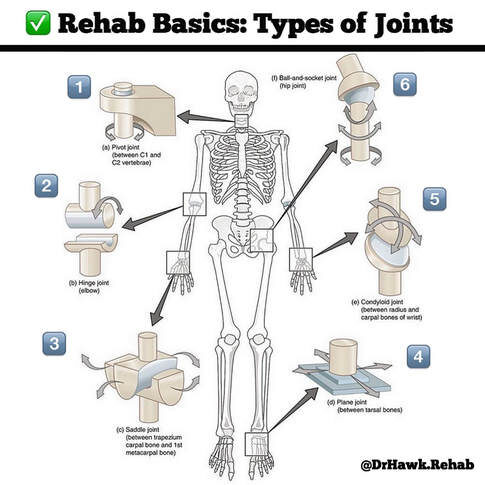💀TYPES OF JOINT MOTION [Anatomy] – Ep.151
.
➡️If you’re a rehab specialist or trainer it’s REALLY important to understand joints. Many people think of the typical shoulder and knee, but there are many more variations structurally (fibrous/cartilaginous) and functionally (no movement vs lots of movement).
.
🔹Above you’ll see the 6 types of synovial joints we have. Synovial are those that allow more movement and have a joint space with fluid.
.
1️⃣Pivot Joints (C1-C2 Vertebra) – allows rotation in one plane
.
2️⃣Hinge Joints (Knee and Elbow) – allows flexion and extension in one plane, but unstable with perpendicular force.
.
3️⃣Saddle Joints (Thumb Joint) – are like special hinge joints. Mostly flex and extend but can do some rotation and side to side movements.
.
4️⃣Plane Joints (Carpal/Tarsal Joints) – basically 2 flat surfaces that glide over each other
.
5️⃣Condyloid Joints (Radio-Carpal Joint) – similar to ball and socket joints, but has less rotation capability because of the oval shape
.
6️⃣Ball and Socket Joints (Shoulder and Hip) – the champion of joints 🏆. Allows for flexion/extension/abduction/rotation. But can be very unstable with high forces
. ✳️Joint Form dictates function ➡️ which dictates injury and rehab. So knowing the physics of the joint you’ve injured really helps with rehab!
.
📝If you’ve injured a joint, can you pick which of the 6 it was? Let me know! ⤵️
.
➡️If you’re a rehab specialist or trainer it’s REALLY important to understand joints. Many people think of the typical shoulder and knee, but there are many more variations structurally (fibrous/cartilaginous) and functionally (no movement vs lots of movement).
.
🔹Above you’ll see the 6 types of synovial joints we have. Synovial are those that allow more movement and have a joint space with fluid.
.
1️⃣Pivot Joints (C1-C2 Vertebra) – allows rotation in one plane
.
2️⃣Hinge Joints (Knee and Elbow) – allows flexion and extension in one plane, but unstable with perpendicular force.
.
3️⃣Saddle Joints (Thumb Joint) – are like special hinge joints. Mostly flex and extend but can do some rotation and side to side movements.
.
4️⃣Plane Joints (Carpal/Tarsal Joints) – basically 2 flat surfaces that glide over each other
.
5️⃣Condyloid Joints (Radio-Carpal Joint) – similar to ball and socket joints, but has less rotation capability because of the oval shape
.
6️⃣Ball and Socket Joints (Shoulder and Hip) – the champion of joints 🏆. Allows for flexion/extension/abduction/rotation. But can be very unstable with high forces
. ✳️Joint Form dictates function ➡️ which dictates injury and rehab. So knowing the physics of the joint you’ve injured really helps with rehab!
.
📝If you’ve injured a joint, can you pick which of the 6 it was? Let me know! ⤵️



